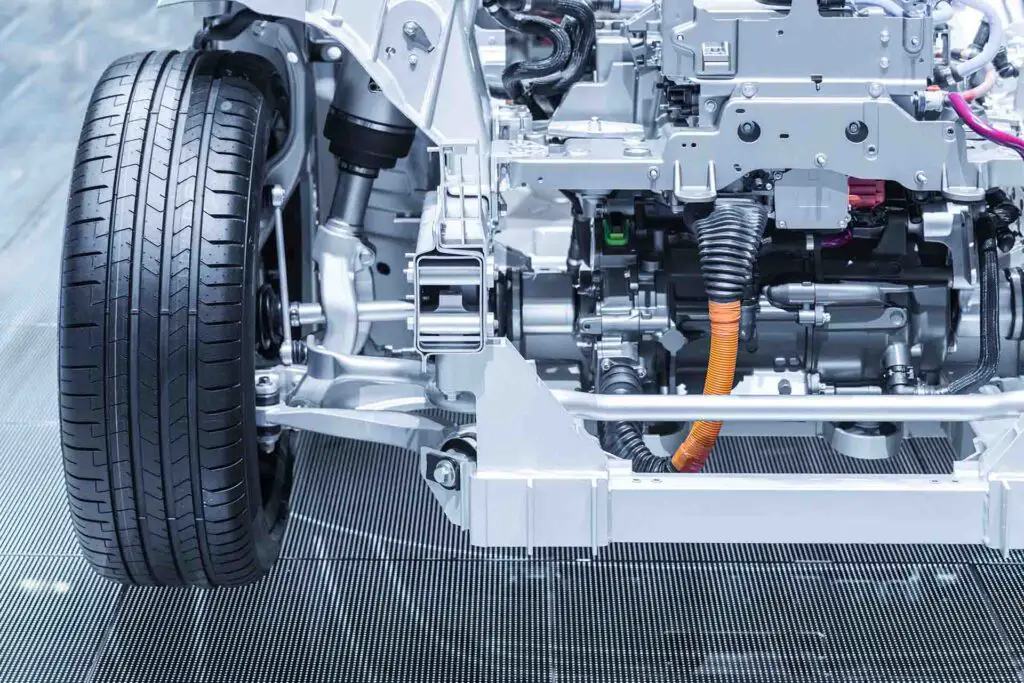For those curious about what lies beneath the hood, the inner workings of their vehicles can be both fascinating and confusing. One of these mysterious components is the limited-slip differential, and you’re definitely not the only one wondering – how does an LSD diff work? So, let’s explain and demystify one of your vehicle’s key systems once and for all.
A limited-slip differential (LSD) is a specialized type of differential that actively distributes torque between the wheels to optimize traction and control. These components utilize various mechanisms to sense and respond to differences in wheel speed and traction conditions, allowing the power to be distributed more evenly while minimizing wheelspin and maximizing traction.
What Types of Differentials Are There?
No matter if it’s a brand-new vehicle with a high price tag or a classic old-timer meant to bring some style to the famous routes in the US – if it’s a four-wheeler, it has a differential. This is a crucial component of a car’s drivetrain system that allows the wheels to rotate at varying speeds while maintaining traction and stability.
Located between the two wheels on an axle, the differential distributes power from the engine to both wheels, enabling smooth cornering and efficient power delivery. By compensating for the difference in rotational speed between the inner and outer wheels during turns, the differential ensures that the wheels receive an appropriate amount of torque, preventing wheel slippage and enhancing overall control.
Open Differentials and Their Limitations
Open differentials are a common addition to the drivetrain system found in a large number of vehicles, from small city cars to popular import vehicles. They allow the wheels on the same axle to rotate at different speeds, facilitating smooth turns and minimizing tire wear.
However, this type of differential has some drawbacks you should be aware of:
- Unequal torque distribution,
- Wheel slip,
- Limited off-road capability,
- Limited power delivery,
- Reduced performance in cornering,
- Limited torque transfer.
Introduction to Limited-Slip Differentials (LSDs)
Limited-slip differentials, simply referred to as LSDs, are advanced drivetrain components designed to address the limitations of open differentials. LSDs use a variety of mechanisms, such as clutch packs or viscous fluids, to distribute torque based on the traction available to each wheel.
This enhanced traction and stability are the reason why LSDs are particularly beneficial in performance-oriented and off-road vehicles, where maintaining traction and power delivery is crucial.
Variations of LSDs
Limited-slip differentials come in various types, each with its unique design and characteristics:
| LSD Type | Description | Pros | Cons |
| Clutch-Type | Utilizes clutch packs to control torque distribution | Smooth torque transfer, improved traction | Requires maintenance, can experience wear and tear |
| Torque-Sensing | Uses a helical gear mechanism to sense and adjust torque imbalance | Seamless torque transfer, excellent performance | Expensive, complex designs may exhibit some torque bias |
| Viscous | Relies on a fluid-filled coupling to transmit torque | Progressive torque transfer, simple design | Heat generation, limited torque capacity, potential fluid leakage |
| Electronic | Incorporates electronic sensors and actuators for torque control | Precise torque distribution, customizable settings | Higher cost, reliance on electronic components |
| Torsen | Employs a mechanical gear-based system to distribute torque | High torque capacity, reliable performance | Less suitable for low-traction situations |
As you can see, each LSD variation has its advantages and disadvantages, allowing drivers to choose the one that best suits their driving style and specific requirements. Now, let’s get into the inner workings of this fascinating vehicle component.

How Does an LSD Diff Work – Basic Operating Principle
Finally, let’s get to the real deal and explain how exactly the limited-slip differentials operate and keep your summer or winter tires spinning. You might be wondering about specific makes and models, for example, about how VW LSD diff works, but the basic principle is more or less the same. So, let’s go over it in further detail.
Distribution of Torque Between Wheels
Torque distribution refers to the allocation of power generated by the engine to the individual wheels, enabling efficient and effective power delivery. Unlike an open differential that allows the wheels to rotate at different speeds, a limited-slip differential can vary the torque delivery to optimize power distribution. The result is improved stability, enhanced cornering performance, and better handling.
Balancing Wheel Speed and Traction
Balancing wheel speed and traction is crucial to maintaining control and stability in a vehicle. The relationship between these aspects is interconnected, and finding the right balance is essential for optimal performance.
LSDs are specifically designed for achieving this balance, as they help distribute torque appropriately between the wheels, allowing for better traction and preventing excessive wheel slip.
Transferring Power to the Wheel With More Grip
LSDs utilize various mechanisms, such as clutch packs, helical gears, or viscous fluids, to sense differences in wheel speed and distribute torque accordingly. By actively directing power to the wheel with more traction, these differentials optimize grip, minimize wheel spin, and enhance overall stability during acceleration, cornering, and off-road maneuvers. All in all, they are a crucial part of fulfilling your basic driver’s responsibility of staying safe on the road.
Reducing Wheelspin and Maximizing Traction
When wheel speed surpasses the available traction, it can result in wheelspin, loss of grip, and compromised control. On the other hand, insufficient wheel speed can limit acceleration and maneuverability. As mentioned, LSDs play a vital role in minimizing wheelspin and maximizing traction, providing safer experiences with no driving stress in diverse road conditions.

What LSD Differential Mechanisms Are There?
I’ve already mentioned a few basic types of limited-slip differentials, but let’s take a closer look at the most common variations to better understand how these crucial drivetrain components operate:
Clutch-Type LSDs
A clutch-type limited-slip differential utilizes clutch packs to control torque distribution between the wheels, consisting of a series of friction plates and clutch discs that are stacked together. Under normal driving conditions, the clutch packs allow the wheels to rotate at different speeds, similar to an open differential. However, when wheel slip is detected, the clutch packs engage and lock, transferring torque to the wheel with more traction.
This mechanism is known to produce smooth and progressive torque transfer suitable for various conditions. However, they may require periodic maintenance because of increased wear and tear due to friction generated by the clutch packs.
Torque-Sensing LSDs
Torque-sensing limited-slip differentials, also known as torque-biasing LSDs, use a helical gear mechanism to sense and adjust torque imbalances between the wheels. As torque is applied, the gears rotate and transfer power to the wheel with more traction, effectively biasing torque distribution. The amount of torque biasing depends on the design and characteristics of the helical gears.
These types of limited-slip differentials provide seamless torque transfer, improving traction and stability during acceleration, cornering, and low-traction conditions. They offer excellent performance on both road and track, delivering enhanced grip and precise control even in the cities with the worst drivers.
Helical LSDs
If torque-sensing LSDs use helical gear mechanisms to adjust torque imbalances, you might be wondering – what does the helical limited-slip differential utilize? Well, it also uses helical gears, but the main difference between these types lies in their specific design and functionality.
Torque-sensing differentials aim to detect and adjust torque imbalances, while helical LSDs focus on distributing torque evenly. When one wheel experiences slippage, the helical gears engage and transfer more torque to the wheel with a better grip. This provides improved traction, stability, and power delivery, especially during cornering or low-traction situations.
What Are the Benefits and Applications of LSD Differentials?
Each type of differential, whether it be an open, limited-slip, or locking differential, has its own set of benefits and is suited to different driving habits. That’s why understanding the benefits and limitations of each differential type allows drivers to select the option that aligns with their specific requirements. So, let’s see if the limited-slip differential is the right pick for you.
Improved Traction on Different Surfaces
Because they transfer power to the wheel with better grip, LSDs can significantly enhance traction on various surfaces, such as snow, gravel, and track. That way, available traction is effectively utilized, resulting in better performance and increased driver confidence in various scenarios. No more driving anxiety if your four-wheeler swerves off the road once in a while.
Enhanced Cornering Stability and Control
So, by allowing each wheel to rotate at different speeds based on traction conditions, LSDs enable smoother and more precise cornering, allowing the driver to maintain better control and navigate turns with confidence.
Whether on winding roads, racetracks, or challenging off-road terrains, the enhanced cornering stability and control provided by an LSD contribute to a more enjoyable and safer driving experience.
Prevention of One-Wheel Spin
Preventing one-wheel spin is one of the key advantages offered by LSDs. In situations where one wheel encounters low traction, such as on slippery surfaces or during aggressive acceleration, this differential improves overall traction and stability, allowing the vehicle to effectively utilize the available grip.
Better Power Delivery and Acceleration
The basic operating principle of the limited-slip differential also helps in ensuring that power is effectively transferred when accelerating. This optimized power delivery reduces wheel spin and maximizes traction, resulting in improved acceleration performance.

What Are Some Considerations and Limitations?
While LSDs offer numerous benefits, there are some considerations and limitations to keep in mind. First and foremost, you should know that, depending on the type and its specific characteristics, there may be a slight change in the vehicle’s handling dynamics, including steering response, turn-in feel, or cornering behavior. It’s definitely something you can get used to, but it’s important to take your driving preferences into account.
Additionally, LSDs may require periodic maintenance, such as fluid changes or clutch pack inspections, to ensure optimal performance and longevity. Another important aspect to consider is compatibility with the electronic stability control (ESC) system, as some LSDs may affect its functionality.

The Mystery Is Solved – You Should Now Asses if Your Car Needs a Limited-Slip Differential
All in all, a limited-slip differential is a fascinating yet complex automotive part capable of greatly improving your car’s performance and handling. By properly educating yourself on the topic, you will be better prepared to decide if installing one might be the right choice for your specific needs. After all, as car owners, understanding our vehicle’s mechanical systems allows us to fully enjoy its performance.








